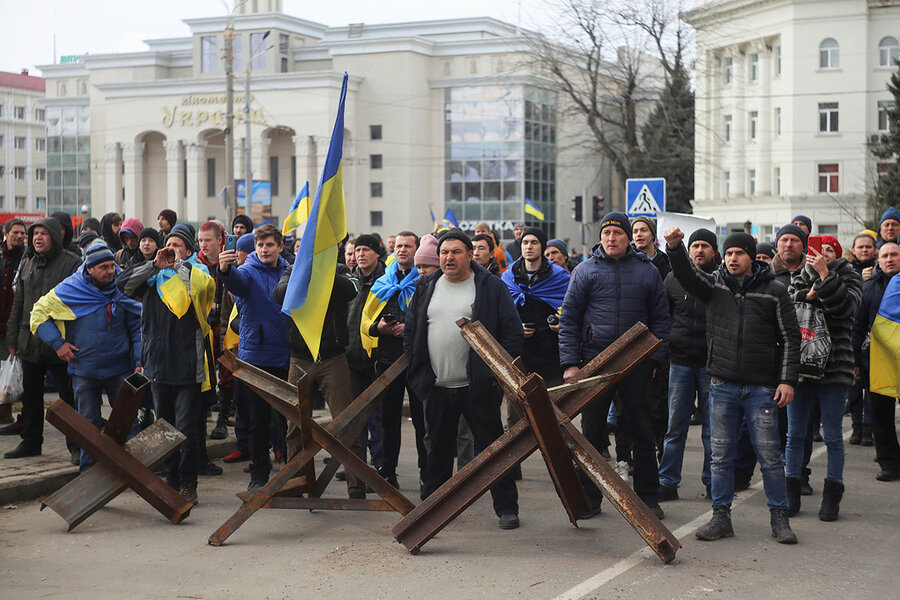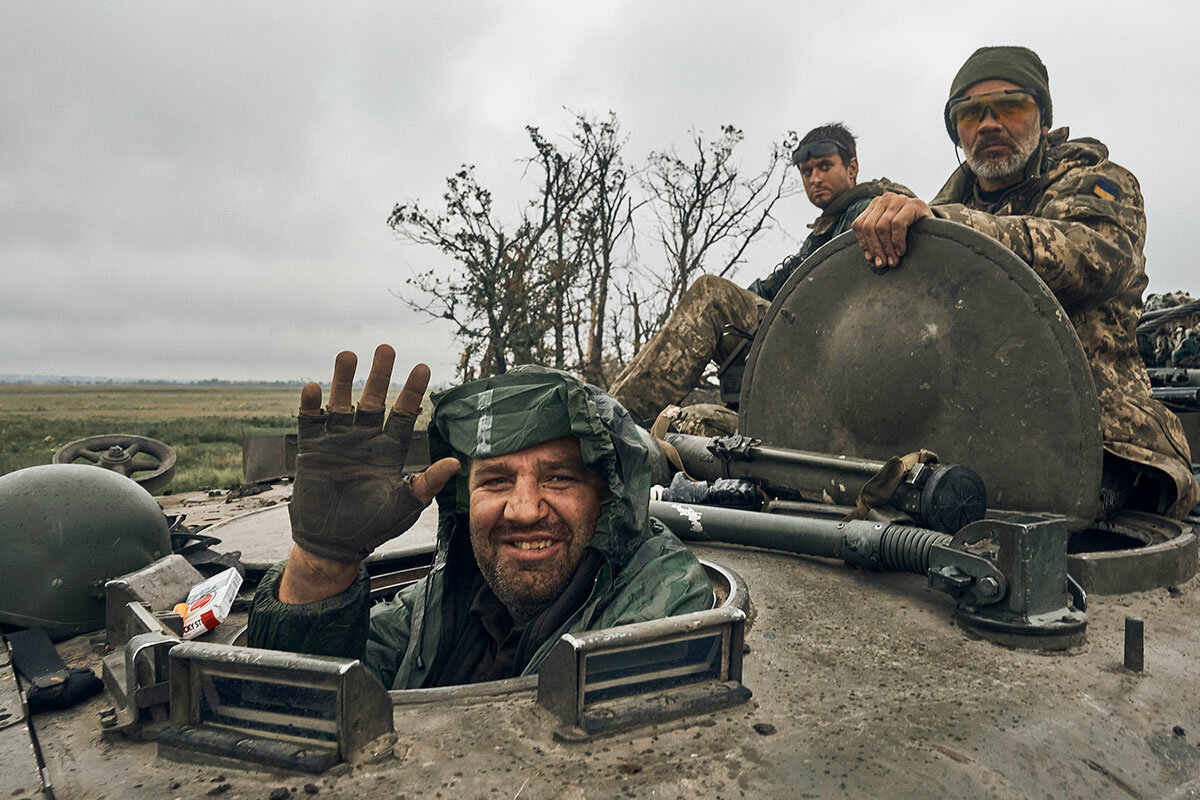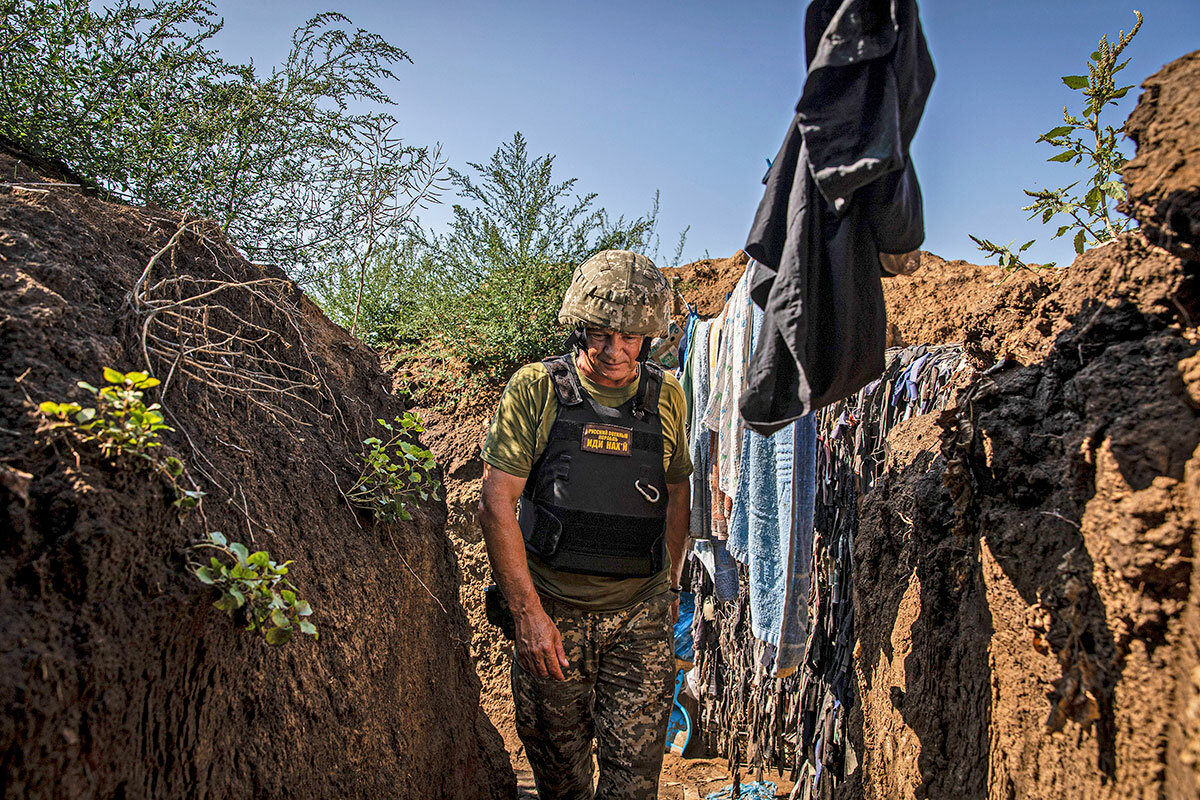For Ukrainians rooting out Russians in south, patience pays
Loading...
| LONDON; and ODESA, Ukraine
The Ukrainian sociologist-turned-guerrilla fighter believes that the liberation of his southern city of Kherson is only a matter of time.
The first city to fall to Russian troops after their February invasion, Kherson has in recent weeks heard the explosive rumble of the Ukrainian military as it slowly advances to end six months of Russian occupation.
Days of street protests that first greeted the Russian presence – and were suppressed with violence – gave way, he says, to carefully calibrated resistance action that has sabotaged Russian military capacity and claimed the lives of some 20 pro-Russian officials, in Kherson and other occupied towns.
Why We Wrote This
A story focused onFew wars do not require perseverance. But for the Ukrainian resistance preparing for months for the promised military advance on Russian forces in and around Kherson, maintaining a patient equilibrium has been key.
“They feel that the walls are watching them,” says the resistance fighter, who asked not to be further identified, for his safety. He says he is on a Russian wanted list, is trained in laying mines and setting explosives, and has moved 25 times since the occupation began.
“From what we hear in the [Russian] intercepts, they are so eager to escape from here,” says the sociologist/fighter.
That is the result of methodical, patient perseverance on the part of the Kherson resistance to undermine the Russian occupation. A key was striking a balance between doing harm to Russian invaders – by creating conditions that will weaken any Russian pushback to the Ukrainian assault – and not inviting severe retaliation.
“For several months we had an order not to touch [Russian troops] at all, to not provoke sanctions against the civilian population,” says the guerrilla.
Those days are over.
Drama near Kharkiv
Yet if the Ukrainian counteroffensive moving toward Kherson was long telegraphed, it has been the lightning advance by Ukraine in the past week far to the northeast that has grabbed headlines and demonstrated to Ukrainians even more dramatically the fruits of perseverance.
Ukrainian forces probing Russian defenses in the Kharkiv region that had been depleted by a redeployment toward Kherson broke through the front lines, surprising Russian troops and forcing them to hurriedly abandon critical and long-held towns and villages.
President Volodymyr Zelenskyy said Monday that Ukraine had recaptured some 2,300 square miles of territory in the past 10 days, with at least 200 square miles of that on the Kherson front. The Institute for the Study of War calculates that reversal to be twice as much territory as Russia had seized in total since April.
In Kherson, the growing Ukrainian military pressure is clear, say pro-Ukraine city residents contacted by phone. It is seen, they say, in the darkening mood of Russian troops and their enablers, as well as in the anxious movement of ammunition and troops, who have seeded themselves among civilians. The pressure has also yielded a first glimmer of hope that liberation may not be far away.
Russian commanders reportedly have already crossed the Dnieper River to the south, and Ukrainian strikes have now destroyed a bridge that was the only escape route in that direction.
The thousands of Russian troops remaining north of the broad expanse of the river must now be resupplied – or must escape – over a fragile pontoon bridge. The Kherson resistance fighter says his unit provided the intelligence that enabled precise targeting of the bridge.
“We will wait as long as necessary,” he says. “We have already heard so many promises of a counteroffensive that will liberate the city that now we do not pay attention – we just do our job.”
And that job, he reckons, entails 80% collecting and analyzing information about “the movement of the enemy” for precision strikes. The remaining 20% is “so-called creative work on the destruction of orcs,” he adds, using a derogatory nickname for Russian troops often given them by Ukrainians that references the evil warriors in J.R.R. Tolkien’s “Lord of the Rings” trilogy.
“We kill no more than 10 to 15 orcs per month,” he says of the toll exacted by his own unit. “Most of the destruction of Russians and explosions is carried out by professionals, those [security and intelligence operatives] who were here before the occupation.
“We killed some local collaborators who did some very bad things,” he says.
After a string of such assassinations in August, Mykhailo Podolyak, a top adviser to the Ukrainian president, tweeted that when Kherson “falls asleep, the partisans wake up.”
The very existence of an organized resistance in Kherson has surprised some residents, who thought there had not been enough time before the Russian occupation to organize underground guerrilla activity, says a former tour guide in Kherson called Anna, who asked not to be further identified.
Many of the activists who took part in initial protests against the Russians were “caught on video and tracked down,” she says. While some left, others “went through torture here in the city.”
Russian troops “expected that locals would welcome them with songs and dancing,” says Anna. “When they realized that this was not the case, they began to tighten the repression.”
Still working is a “yellow ribbon movement,” which decorates the city with Ukrainian symbols, and defaces pro-Russia billboards and posters.
“It takes a lot of resources to organize such activities. ... In Kherson it is impossible to buy a can of spray paint, but from somewhere this graffiti appears,” says Anna.
“Any show of resistance lets the occupation authorities know that ... Kherson is Ukraine,” she says. “It is also very strong support for the locals, because you understand that you are not alone.”
Russia’s plan to hold a referendum in Kherson on joining Russia was shelved due to the “security situation,” pro-Russian officials said last week.
Kherson’s Russia supporters
As Ukrainian troops advance and the sound of artillery is constant, residents “understand that the price of liberating Kherson will be enormous,” says Anna, adding that she is almost certain to leave the city “because it is all a strong psychological trauma.”
“I won’t be able to walk the streets and see all the collaborators I know by sight,” she says. “My concern as a resident of the city is not how to beat the Russian military out of this city; it is how to chase away the rot that has settled here.”
Indeed, Kherson has had its share of pro-Russia citizens.
“In the first couple of months there were people who said, ‘Calm down, Russia is here forever,’” recalls Anna. But today, “we can see the real results of the fact that the front is already close.”
“Those people who were waiting for Russia are in panic mode, to put it mildly,” she says.
As Ukrainian forces approach Kherson, Russian searches of cars have become increasingly intrusive and frequent, she says; many families that arrived with Russian intelligence and occupation authorities – in anticipation of a permanent stay – have now also departed.
Reporting on the situation in Kherson has been the Ukrainian media platform Vgoru, which began work in 2002 and still reports with a team of clandestine correspondents both inside and outside the city.
The occupation boosted Vgoru’s 200 Telegram subscribers to 8,000, and its readership on Facebook has soared from 300,000 to as many as 2 million people.
As it has in other parts of Ukraine it has occupied, Russia has tried to introduce the Russian ruble as currency in Kherson and impose the Russian language and school curriculum in advance of any attempted referendum.
“Resistance in Kherson is to pay in [Ukrainian] hryvnia, it is to speak Ukrainian, and it is to continue to educate your children online in a Ukrainian school and not send them to a Russian school,” says a journalist with Vgoru called Liza, who asked that only her first name be used.
Constant shelling has made some residents blasé about their own safety, including, Liza says, her grandmother, who lives close to a Russian military base and often hears Ukrainian rockets flying past on the way to their Russian target. She tells her granddaughter she won’t move, “because these sounds make me happy.”
“The liberation of Kherson will be a great victory,” says Liza. “But it will also be a very bitter victory, because the full scale of the crimes committed by the Russians will be revealed to us. People are tortured, people are kidnapped, and most don’t talk about it because people are afraid.”
For resistance, much work remains
The sociologist-turned-guerrilla knows those risks too well. The day the war began, he enlisted with the Territorial Defense Forces. But within days, Russian forces swept into Kherson, overnight putting his unit onto a resistance footing.
With little time to establish secure communications, the new “resistance” simply exchanged phone numbers. When the Russians captured officers, like his company commander, those phone numbers revealed the identities of active resistance members.
“Many stayed here; many of them were caught,” says the resistance fighter.
But today as Russian troops display anxiety, “the mood [among pro-Ukraine residents] is very high, and people are optimistic.”
“I try not to fixate on my expectations about when the liberation of Kherson will happen, because I do not want to go through stages of disappointment, anger, and depression,” he says.
“We realize how much work we have to do, what forces are fighting against us,” notes the resistance fighter philosophically.
But the Russian forces were caught off guard, he adds. They “consolidated many of their positions to prepare for their next offensive.”
“They did not prepare for defense ... and this is not playing into their hands.”








